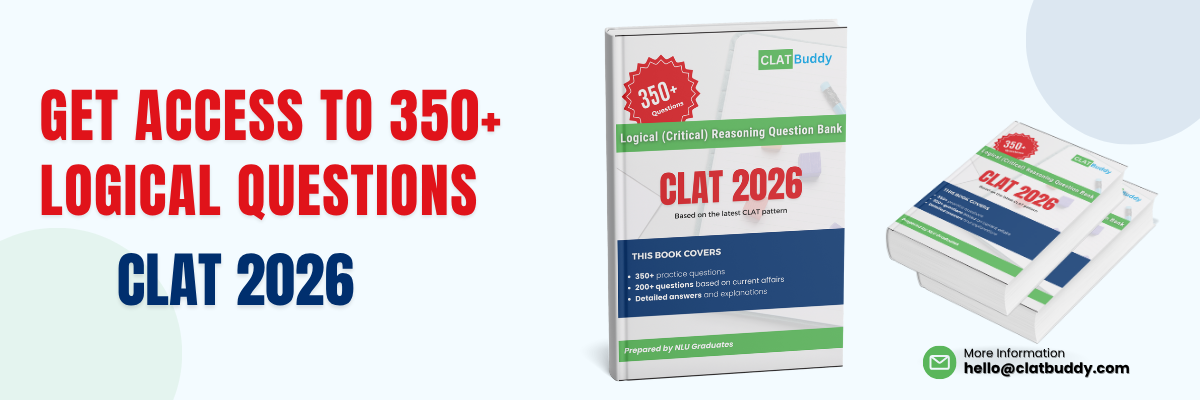Logical Reasoning Questions for CLAT | QB Set 14

Directions: Read the following passage and in light of the same, answer the questions that follow.
In refusing to entertain ‘sealed covers’ submitted by the government or its agencies, the Supreme Court has made a noteworthy and welcome shift away from this unedifying practice. At least two Benches have spoken out against it. Recently, in the Muzaffarpur shelter home sexual abuse case, Chief Justice N.V. Ramana wondered why even an ‘action taken’ report should be in a sealed envelope. The use of material produced in a ‘sealed cover’ as an aid to adjudication is something to be strongly discouraged and deprecated. However, it gained much respectability in recent years, with contents withheld from lawyers appearing against the government, but being seen by the judges alone. Unfortunately, in some cases, courts have allowed such secret material to determine the outcome. In a recent instance, the Kerala High Court perused confidential intelligence inputs produced in a sealed envelope by the Union government to uphold the validity of orders revoking the broadcasting permission given to Malayalam news channel Media One on the ground of national security.
It is quite disconcerting to find that courts can rule in favour of the government without providing an opportunity to the affected parties to know what is being held against them. In this backdrop, it is significant that the Supreme Court has decided that it will examine the issue of ‘sealed cover jurisprudence’ while hearing the channel’s appeal. For now, the apex court has stayed the revocation order and allowed the channel to resume broadcasting. It is true that the law permits the submission of confidential material to the court in some cases. In addition, courts can order some contents to be kept confidential. The Evidence Act also allows the privilege of non-disclosure of some documents and communications. The government usually justifies the submission of secret material directly to the court, citing national security or the purity of an ongoing investigation. Courts have often justified entertaining material not disclosed to the parties by underscoring that it is to satisfy their conscience.
[Source: The Hindu]
Questions and Answers
1. Which of the following represents the central idea of the passage?
(a) Sealed cover defies the conscience of justice delivery system in the country.
(b) Courts proceeding with the practice of sealed cover devalue the rights of parties to the case.
(c) Supreme court has been criticising the practice of sealed cover.
(d) The practice highlights decaying of basic freedoms to the accused.
Answer: (a)
2. Which of the following is the author most likely to agree with in accordance with the passage?
(a) Sealed cover as a practice should be discouraged as it takes away all the rights of accused.
(b) Judges are often been criticised and are in spotlight when they promote such practices.
(c) Sealed cover makes the state avoid deep scrutiny of the proportionality of its restrictions on freedom. ✅
(d) Courts in all the cases have vociferously argued against this arbitrary practice.
Answer: (c)
3. Which of the following can be inferred from the above passage?
(a) The time has come for courts to intervene and red-flag the ad-hoc practice. ✅
(b) Majority of High courts have justified this practice under the garb of “national security” concerns.
(c) Supreme court’s views on the practice have an influential impact on several high courts.
(d) Judiciary is to be seen more inclined towards executive by favouring such practices.
Answer: (a)
4. Which of the following will be most appropriate course of action to curb or limit this practice?
(a) The action can be regarded as just only when it passes through proportionality test. ✅
(b) The act which mandates such practice should be repealed.
(c) The practice has entered into realm of justice delivery system and courts have to be equipped to it.
(d) High Courts should start exerting their influence to restrict the practice in equivalent courts.
Answer: (a)
5. What purpose does the boldfaced statement serve in the passage?
(a) It is an argument to support how the practice is a worrying cause in judiciary.
(b) It is a premise to support how this practice erodes the tenets of justice. ✅
(c) It is a premise to support that courts have broadened the concept of justice.
(d) It is an argument to support that courts have expanded their inquisitive role to uphold the democratic value.
Answer: (b)
Calling all law aspirants!
Are you exhausted from constantly searching for study materials and question banks? Worry not!
With over 15,000 students already engaged, you definitely don't want to be left out.
Become a member of the most vibrant law aspirants community out there!
It’s FREE! Hurry!
Join our WhatsApp Groups (Click Here) and Telegram Channel (Click Here) today, and receive instant notifications.








